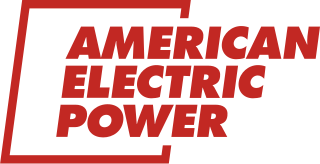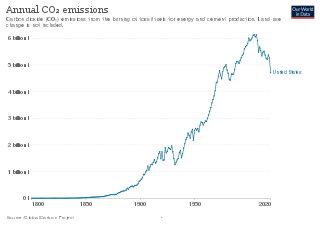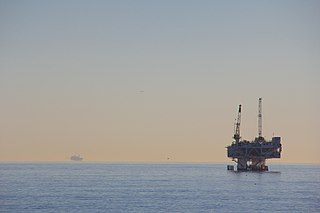
American Electric Power Company, Inc. (AEP), is a major investor-owned electric utility in the United States, delivering electricity to more than five million customers in 11 states.

The Virgil C. Summer Nuclear Power Station occupies a site near Jenkinsville, South Carolina, in Fairfield County, South Carolina, approximately 20 miles (32 km) northwest of Columbia.

The energy policy of the United States is determined by federal, state, and local entities. It addresses issues of energy production, distribution, consumption, and modes of use, such as building codes, mileage standards, and commuting policies. Energy policy may be addressed via include legislation, regulation, court decisions, public participation, and other techniques.
SCANA Corporation was a regulated electric and natural gas public utility. The company was based in Cayce, South Carolina, a suburb of Columbia, South Carolina. Following the Nukegate scandal, the company's stock fell and the company was in disrepair. In January 2019, SCANA was acquired by Dominion Energy. The corporate name SCANA was not an acronym, but was taken from the letters in South Carolina.

Most of the energy used in the United States in 2021 came from fossil fuels, as 36% of the nation's energy originated from petroleum, 32% from natural gas, and 11% from coal. Nuclear power supplied 8% and renewable energy supplied 12%, which includes hydroelectric dams, biomass, wind, geothermal, and solar.

Making up over 55% of the state's generated electricity in 2021, wind power is the largest source of electricity generation in Iowa. In 2020, over 34 billion kWh of electrical energy was generated by wind power. As of Q3 2020, Iowa has over 10,951 megawatts (MW) of installed capacity with 5,590 wind turbines, ranking 2nd and 3rd in the nation below Texas respectively.

Wyoming has one of the highest wind power potentials of any state in the United States. In 2019, Wyoming had wind powered electricity generating capacity of 1,589 MW, which produced 9.85% of its electric generation, with an additional 3,753 MW under construction. However, the wind generation in that year was Wyoming's third-lowest in the 2010s. By 2020, wind capacity increased to 2738 MW and 8448 gigawatt-hours of electricity were produced from wind in 2021, more than double 2019 production. Additional wind capacity and needed transmission lines are under construction or planned, despite political headwinds from Wyoming's strong coal and oil sectors.

Wind power in Illinois provided nearly 10% of the state's generated electrical power in 2020 powering 1,231,900 homes. At the end of 2020, Illinois had 6,300 megawatts (MW) of wind power installed, ranking fifth among states for installed wind turbine capacity. An additional 1,100 MW of wind power was under construction across the state at the end of 2020.
There is a large array of stakeholders that provide services through electricity generation, transmission, distribution and marketing for industrial, commercial, public and residential customers in the United States. It also includes many public institutions that regulate the sector. In 1996, there were 3,195 electric utilities in the United States, of which fewer than 1,000 were engaged in power generation. This leaves a large number of mostly smaller utilities engaged only in power distribution. There were also 65 power marketers. Of all utilities, 2,020 were publicly owned, 932 were rural electric cooperatives, and 243 were investor-owned utilities. The electricity transmission network is controlled by Independent System Operators or Regional Transmission Organizations, which are not-for-profit organizations that are obliged to provide indiscriminate access to various suppliers to promote competition.

NextEra Energy, Inc. is an American energy company with about 58 GW of generating capacity, revenues of over $18 billion in 2020, and about 14,900 employees throughout the US and Canada. It is the largest electric utility holding company by market capitalization. Its subsidiaries include Florida Power & Light (FPL), NextEra Energy Resources (NEER), NextEra Energy Partners, Gulf Power Company, and NextEra Energy Services.

Energy in California is a major area of the economy of California. California is the state with the largest population and the largest economy in the United States. It is second in energy consumption after Texas. As of 2018, per capita consumption was the fourth-lowest in the United States partially because of the mild climate and energy efficiency programs.

Pinopolis Dam is a dam in Berkeley County, South Carolina.

The U.S. State of Oklahoma has high potential capacity for wind power in the western half of the state. In 2021, Oklahoma's installed wind generation capacity was almost 10,500 megawatts, supplying over 40% of the state's generated electricity and 85% of Oklahoma's total generating capacity from all renewable resources.
Cross Generating Station is a 2,390 MW, four unit coal-fired power station located in Pineville, South Carolina. It is owned by Santee Cooper, formally known as the South Carolina Public Service Authority. The nameplate capacity of each unit is 590.9 MW, 556.2 MW, 591 MW, and 652 MW respectively. In 2016, Cross switched from using higher quality bituminous coal, to refined coal, which is a lower quality coal that is refined to release less toxins and is backed by the US government. The future of the plant has become more uncertain due to downward trends in use, talks of shuttering the station, and converting it to natural gas. However, no official statements have been made on the future of the plant.

The Nukegate scandal is a political and legal scandal that arose from the abandonment of the Virgil C. Summer nuclear expansion project in South Carolina by South Carolina Electric & Gas (SCE&G) and the South Carolina Public Service Authority in 2017. It was the largest business failure in the history of South Carolina. Before its termination, the expansion was considered the harbinger of a national nuclear renaissance. Under joint ownership, the two utilities collectively invested $9 billion into the construction of two nuclear reactors in Fairfield County, South Carolina from 2008 until 2017. The utilities were able to fund the project by shifting the risk onto their customers using a state law that allowed utilities to raise consumers' electricity rates to pay for nuclear construction.












